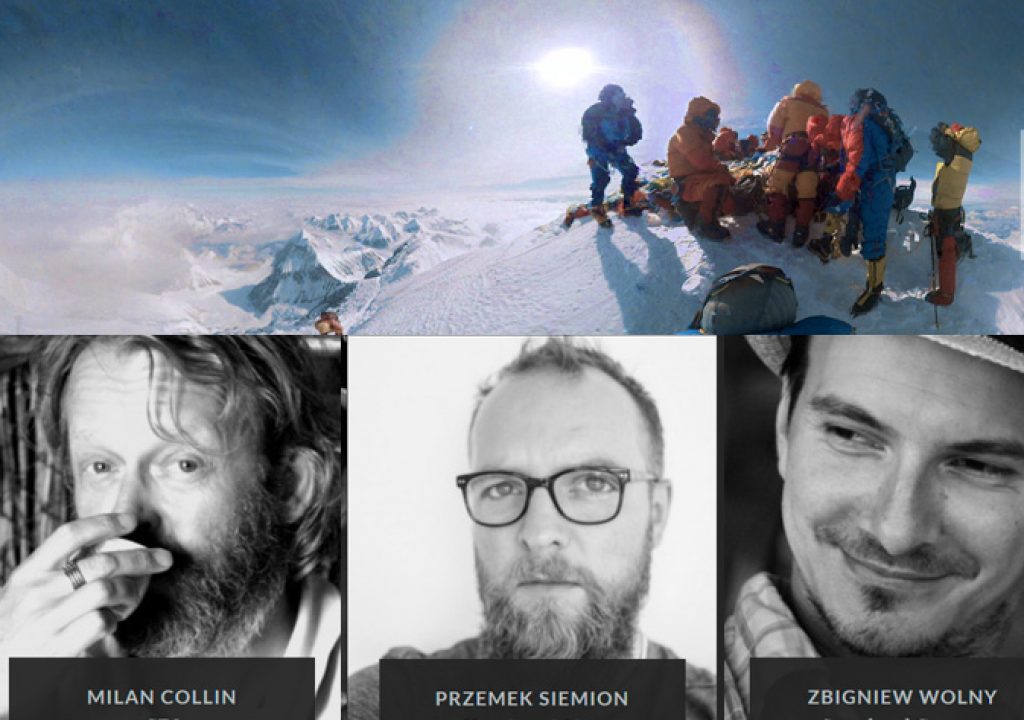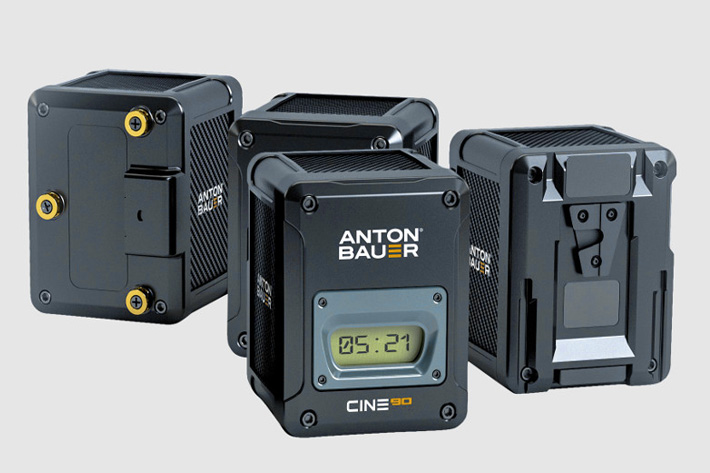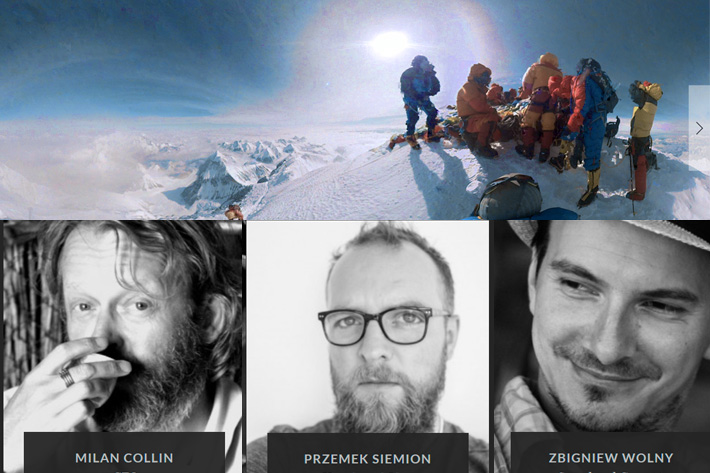
Last May filmmaker and post-production artist Przemek Siemion and the VR Explorers’ team joined renowned Irish adventurers and guides Noel and Lynn Hanna on an epic quest to capture cinematic VR in one of the world’s most extreme environments.
As one of the most difficult treks on the planet, not many are willing to climb to Mount Everest’s summit and face altitude sickness, high-speed winds, and the possibility of major avalanches. But now, thanks to new technology and an innovative production company, you might not have to risk your life to experience the journey. For Amsterdam-based production company VR Explorers, they didn’t just set out to reach the top, they also became the film industry’s first-ever production team to capture virtual reality footage from the storied mountain’s peak at roughly 8,848 meters above sea level. Siemion’s crew aimed to capture the summit as well as the overall journey for viewers.
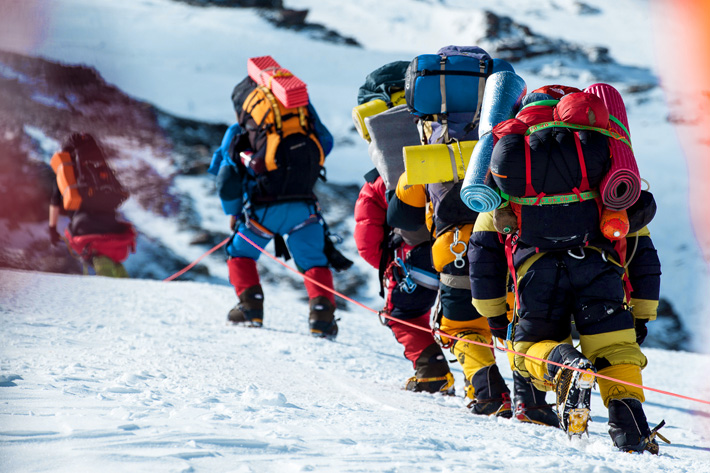
We interviewed the team about the technical aspects of such a climb and the problems filming under such harsh conditions. We also asked how each of them felt about the experience of creating ClimbEverestVR.
“Other VR companies had tried before but they failed. This was our big challenge,” explained Siemion. “Luckily, our production company had experience from a previous film on Mount Everest so we knew what the climb would look like and what the conditions would be.”
The team started their expedition in Kathmandu, Nepal before flying to neighboring peak Lhotse and driving to their base camp at 5,000 meters. Once there, their group of 16 climbers and 30 Sherpas spent six weeks acclimating to the elevation by traveling up and down the trails from base camp – going a little further each time.
“When you go above 7,000 meters, every breath counts. Your body can’t recover and it really begins to deteriorate. I would notice new scratches on my hands just from wearing gloves.”
With the human body wearing down, their equipment had to be especially robust to perform at that kind of extreme elevation. Knowing previous expeditions with larger cameras had failed, VR Explorers put together an innovative and lightweight kit. The crew relied on GoPros, monopods, sound equipment, Litepanels LED lights, computers, and cards – plus Anton/Bauer Cine 90 batteries and the Performance Quad charger.
“Because of the harsh conditions, we had to scale down on the weight of our kit and we knew that mobile power would be a challenge. That was why we used Anton/Bauer. The Performance Quad Charger performed great and we had no problem charging the batteries based on these conditions. Not to mention, the CINE 90s were smaller and lighter weight – it was really easy to pack and plan our rig around it. It was so convenient and we used them for everything.”
In addition to being able to power the kit to the summit, Siemion found that the CINE batteries were robust enough to power their other equipment. He ended up preparing special plates that enabled him to charge all of his gear with Anton/Bauer CINE batteries, including the cameras, audio equipment, and even his iPhone.
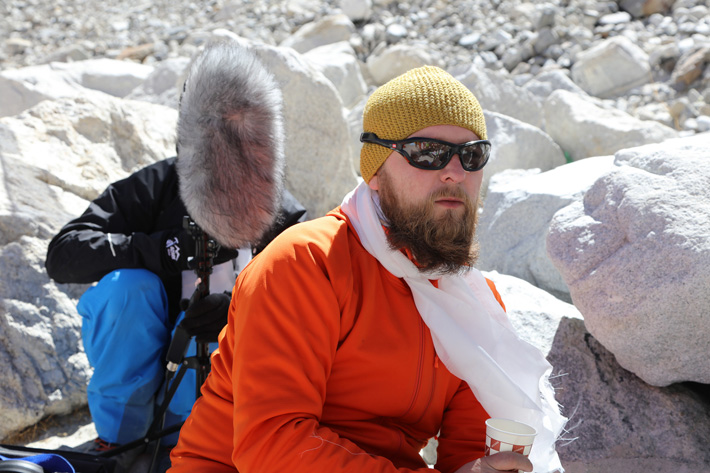
“From the get-go, we made sure we could charge everything from the Anton/Bauer batteries including the audio equipment and the GoPros. We also brought the batteries we used on our last trek and they just didn’t perform and they couldn’t charge off of the solar-powered generators we were using at base camp. The Anton/Bauer CINEs were the only ones that worked and really saved us. Without working batteries, we wouldn’t have been able to do anything.”
Along with its reliability, Siemion highlighted how important the battery’s easy-to-read LCD was during the trip. With the display, he was able to see the battery’s precise run time when attached to the camera and the percent of charge when off-camera.
“I loved the visual display. In those conditions, it’s nice to see exactly how much run time you have and the percentage of charge. I really appreciated that while we were up on the mountain.”
Overall, power was never an issue that Siemion and his team had to worry about while conquering the next biggest achievement in the digital video world.
“On our way back, we had to stop recording because the camera’s video card was full despite the fact that we still had 8% of battery power left. We even helped others with charging their equipment. Other batteries just don’t perform like that. Anton/Bauer was the only one that worked perfectly.”
The VR film is planned for release in early 2017. There is a whole work with post-processing that has kept the team busy since they returned from their adventure. Despite the busy schedule, the team at VR Explorers – Przemek Siemion, Zbigniew Wolny and Milan Colin found the time to tell ProVideo Coalition about their individual experience. Here is the interview.
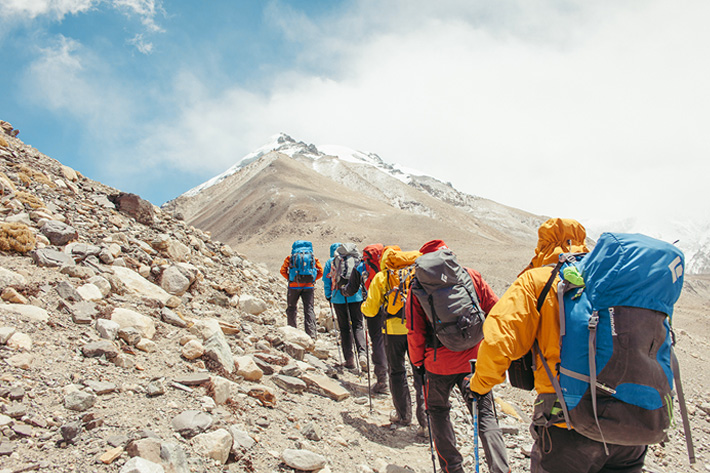
PVC – Technical aspects aside, how was it to capture video under such conditions? How does it feel to have a camera in your hands up there?
Milan Colin – From the beginning we knew that we were not going to the summit ourselves. We did not have this altitude experience, but we tried to get up as high as possible! Przemek reached a good height of around 7,400 meters, and from there on Noel took over the camera. We instructed him in a way that he knew exactly what to do, how to film and record the right sound. It’s difficult to let this important responsibility out of our hands, but safety always comes first.
He came back with a four hours of amazing climbing footage, and of course we were happy to see that the summit was amongst that footage.
Przemek Siemion – Filming in Himalayas was an amazing experience. I have unlimited admiration for those mountains – every working day was like a gift. It was a challenge and a test for us. Every day I thought I reached the limit of my physical limits; each day after proved to me that I was wrong. Eventually I grew with the mountains, feeling my body adjusting to those extreme conditions and believing that I could do more. It was as if the mountain was allowing me to be there and challenging me at the same time. Having experience with filming there already (Milan was filming there at 2008), we planned for our script, shooting scenarios, and gear to be as flexible as possible. In the process we learned a lot, and decided to be more open to ideas that we came up with during our expedition, even if we weren’t able to test all of them beforehand. It was a gamble, just like the whole idea of the production, but I think we managed it well.
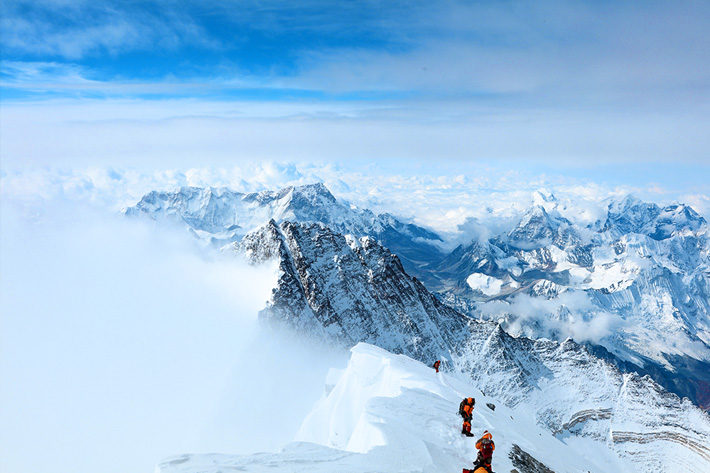
PVC – In the past you’ve focused on using cross-media innovations to enhance emotional human storytelling. How much storytelling is present in this video of adventurer Noel Hanna and his wife Lynn in their second Everest ascension? Or has the VR technique been the most important aspect?
Zbigniew Wolny – Our main idea was to let a viewer experience how is it to be a part of the Mount Everest expedition. You travel with Noel and Lynn from Kathmandu, through Tibetan villages, to reach Everest Base Camp and all the high camps. Finally, you climb up the North Side of the highest mountain to eventually reach the top of the world. During this trip, your guide will share with you lots of interesting stories and tips regarding the preparation, the everyday life situation in camps and practical information. We also witness Noel and Lynn being the first couple that summits Everest from both sides.
M.C. – The storytelling part is the biggest adventure of all. At the office, you can plan how to do something. You can even go and try with Noel and Lynne, but finally it all happens on the mountain and there you need to have the right setting. Sometimes it worked and sometimes we missed opportunities. You cannot do a retake as you do on sea level. Of course that is also the charm of this kind of producing, the purity and wildness.
P.S. – I could only add that we thought about storylines and ideas beforehand, planned for certain outcomes and tried to chase storylines. The most important components for us were to create the first VR series from Everest, and to make it interactive so as to enhance the idea of audience participation and being a part of the whole expedition.
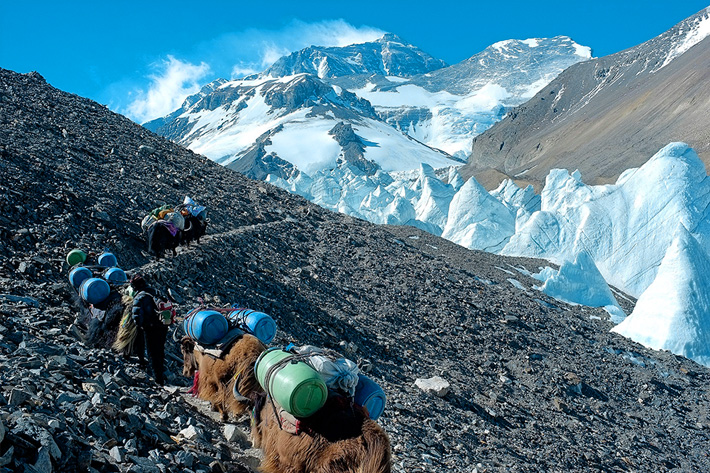
PVC – This is, one could say, VR at its highest point. Filming in normal conditions is already difficult. How hard was it to produce cinematic VR in these most extreme environments?
Z.W. In short, very hard. This is a place not really suitable for humans to stay for a longer period of time. Starting from altitude that drastically limits your physical abilities – you are out of breath, way slower in movement, often with a headache. Harsh climate, extreme temperatures, strong winds – it all affects your body and at the same time the way of filming.
Additionally, we had to listen to the expedition leader – he makes all decisions and plans regarding when and how the expedition will proceed to ensure all climbers will have a chance to reach the top and come down safely. Noel’s main mission was to guide and take care of his clients. All these factors affected the initial script and demanded a great deal of flexibility and some compromises on our side.
P.S. It’s important to keep in mind that we were just a 2 band crew, and the challenges we encountered were comparable with Olympic games at the highest level! You spend 20 hours some days completing the tasks that need to be done so you can start the next day with a clean sheet. Of course altitude takes a big toll on you and you hope you can keep up with those strong athletes. They are training every day for such a long time to go here and climb the mountain. Our training was preparing all the stuff we needed to take and dealing with the stress that goods will not be in time, like the cameras were coming in one day before departure. We were not able to do a proper test of all the equipment before we left, due to last minute deliveries, caused by delayed shipment.
In all honesty I can say this is one of the most difficult places to produce something in VR.
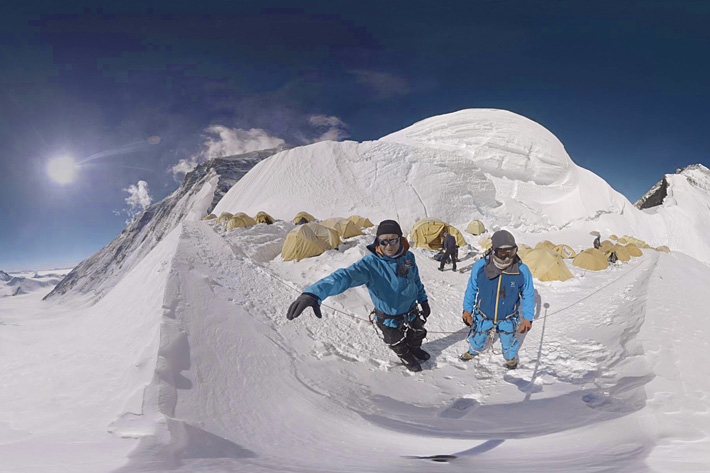
PVC – You’ve created a special rig for this project. Did you not find anything suitable on the market?
P.S. – In preparation we were playing around with many rigs and tried to create the perfect setting. Very early in the research and testing for finding our camera rig we had to abandon the idea of shooting stereo, which for me was a tough call because I believe that stereoscopic is the way to go with VR. After talking with many friends in our industry we opted for a GoPro based solution. This was also a reason why we didn’t want to shoot stereo, because the risk of failure was growing with a larger number of cameras. We wanted to use DSLR based rigs, thought about Nokia OZO, but they were either too complicated to use, not available to us, or simply too heavy. Weight was a huge factor. From two rigs we planned to send, only the top one was used. It was the climber’s last minute decision not to take it since it was too heavy (about 1700 grams). In general, we had 3 rigs, two custom rigs with GoPro cameras fitted with the Back-Bone Ribcage modification, plus wide angle lenses from Entaniya, and the last rig was our backup rig, Freedom 360. We powered all our components, cameras and audio gear with Anton Bauer Cine 90 batteries, which worked like a charm, and performed very well in those conditions. Many times other batteries lost their charge, and I frequently used Cine 90 to charge other batteries or even other cameras for other climbers.
PVC – Sound is another important aspect on VR. How did Zbigniew Wolny, a sound recordist with whom you’ve worked in different occasions, get the sound for this film?
Z.W. – As a very important part of the overall viewer’s experience, I tried to capture sound with proper attention. To provide immersion, audio was recorded with an ambisonic microphone which was supported by additional lavalier mics.
I had to find a solution for how Noel could record himself on the mountain alone, with equipment that withstands extremely low temperatures and is very easy to operate. The wind was another issue that had to be solved. We captured a good number of interesting interviews and soundscapes.
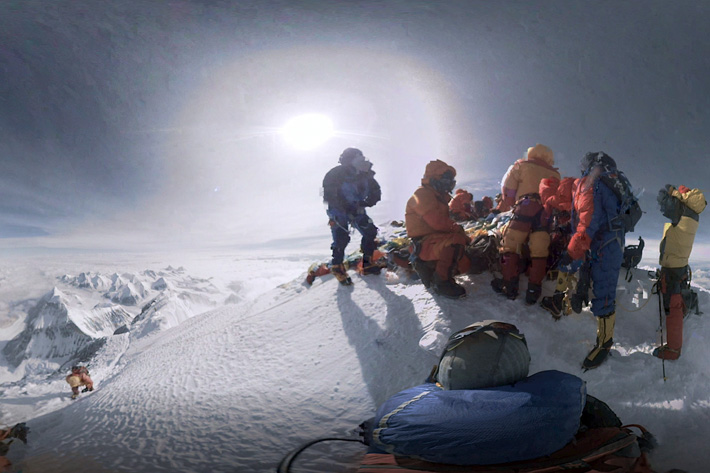
PVC – Any special moments you want to share from this adventure? Funny situations?
P.S. There were definitely a few. The biggest one was our Entaniya fisheye lenses were assembled with GoPros for the first time in Kathmandu, but later on in Base Camp I discovered that some of them were not in focus and I had to fix them. They got stuck, probably because of the pressure, and I had to open the lens from the camera. I asked the strongest guys around to do it, but no one could open the lens from the GoPros. The way I fixed it in the end was a gamble: I used a car wrench from a Toyota Land Cruiser to fix those small cameras. There was a chance of completely ruining the lens mount and camera itself by doing so, but it worked!
I was also amazed by how often those conditions made the cameras stop working. There was a television crew from Russia with some serious gear (Arri Alexa included), but most of their handheld cameras stopped working on the summit.
PVC – Did all the equipment work as expected? Did you have to change some of the planning due to unexpected problems?
P.S. – In general our equipment performed very well, and I was surprised how smooth it went. Regarding planning, many times we had to adjust to the situation on the mountain, so we had to make fast decisions: what to take and when, as carrying all the gear was not an option due to limited access to porters and the overall weight. In other words, our planning was changing a great deal – most of the time we found out only an hour beforehand, sometimes the night before, if we were lucky.
PVC – What will come after ClimbEverestVR? What other projects are you working on?
M.C. – We are working on many other interesting projects at the moment. Not all adventure as we also like to create experiences that could be beneficial for people with particular needs, such as in the health and training sectors. Yet, the field we love the most is travel and adventure. We are now creating a beautiful new series about the most amazing caves in the world. Apart from deepest seabeds, these are the least known and explored places on our planet. We’d love to let people experience the eerie beauty of these million-year-old inner earth landscapes.

Filmtools
Filmmakers go-to destination for pre-production, production & post production equipment!
Shop Now